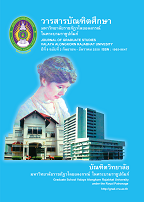ตัวแบบการประหยัดพลังงานไฟฟ้าในครัวเรือน และชุมชนในเขตจังหวัดภาคกลางของประเทศไทย THE MODEL OF ELECTRICAL ENERGY SAVING IN HOUSEHOLDS AND COMMUNITIES IN THE CENTRAL REGION OF THAILAND
Main Article Content
Abstract
บทคัดย่อ
การวิจัยนี้มีจุดประสงค์เพื่อ 1) เพื่อศึกษานโยบายภาครัฐ สภาพปัจจุบัน ปัญหาของการจัดการพลังงานไฟฟ้าในครัวเรือน และชุมชนในเขตจังหวัดภาคกลางของประเทศไทย 2) เพื่อศึกษาแนวทางการจัดการพลังงานไฟฟ้าในครัวเรือน และชุมชนในเขตจังหวัดภาคกลางของประเทศไทย 3) เพื่อนำเสนอตัวแบบการประหยัดพลังงานไฟฟ้าในครัวเรือน และชุมชนในเขตจังหวัดภาคกลางของประเทศไทย การวิจัยนี้ใช้การวิจัยแบบผสานวิธีประกอบด้วยการวิจัยเชิงปริมาณ และการวิจัยเชิงคุณภาพ การวิจัยเชิงปริมาณดำเนินการโดยการศึกษากลุ่มตัวอย่างจำนวน 392 คน ที่กำหนดขนาดโดยใช้การคำนวณตามสูตรของทาโร ยามาเน และเพื่อเพิ่มความเชื่อมั่นของข้อมูล และให้ได้ข้อมูลครบถ้วนสมบูรณ์ ผู้วิจัยจึงเก็บเพิ่มเป็น 500 คน ที่สุ่มตัวอย่างแบบหลายขั้นตอน จากประชากร 5 จังหวัดในเขตภาคกลาง ได้แก่ จังหวัดพระนครศรีอยุธยา จังหวัดลพบุรี จังหวัดนครนายก จังหวัดสระบุรี และจังหวัดอ่างทอง เก็บข้อมูลโดยใช้แบบสอบถาม แบบมาตราประมาณค่า 5 ระดับ วิเคราะห์ข้อมูลโดยใช้สถิติพรรณนา ได้แก่ ค่าร้อยละ ค่าเฉลี่ย และค่าส่วนเบี่ยงเบนมาตรฐาน สำหรับการวิจัยเชิงคุณภาพ ดำเนินการโดยการสัมภาษณ์เชิงลึก ผู้ให้ข้อมูลสำคัญ จำนวน 50 คน ที่เลือกแบบเจาะจง จากผู้เชี่ยวชาญด้านพลังงานกระทรวงพลังงาน ในพื้นที่ 5 จังหวัดเดียวกันเพิ่มเติมด้วยการระดมสมองและการสนทนากลุ่ม วิเคราะห์ข้อมูลโดยใช้การวิเคราะห์เชิงเนื้อหาประกอบด้วย การตีความและการแปรความและสร้างข้อสรุปจากข้อมูลที่ได้
ผลการวิจัยพบว่า
1. นโยบายภาครัฐ สภาพปัจจุบัน ปัญหาของการจัดการพลังงานไฟฟ้าในครัวเรือนมีความสำคัญมากกว่าอดีต เพราะสภาพการใช้พลังงานไฟฟ้าทั้งในระดับครัวเรือนและชุมชน มีแนวโน้มสูงขึ้นเรื่อยๆ เนื่องจากมีการขยายของตัวเมือง ที่อยู่อาศัย ผู้ประกอบการร้านค้า สิ่งปลูกสร้าง สถานศึกษา หน่วยงานราชการ และมีการใช้อุปกรณ์ไฟฟ้าเพิ่มขึ้น การบริหารการจัดการพลังงานไฟฟ้าของเขตชุมชนเมืองและเขตชนบทยังไม่มีรูปแบบการบริหารการจัดการที่เป็นรูปธรรมชัดเจน ขาดการบูรณาการ การทำงานร่วมกับครัวเรือน และชุมชนและหน่วยงานที่เกี่ยวข้อง และยังขาดการมีส่วนร่วม การสื่อสารการประชาสัมพันธ์ การให้ความรู้ และขาดการรณรงค์ส่งเสริมให้ประชาชนเกิดความตระหนักและร่วมมือในการประหยัดพลังงานไฟฟ้าในครัวเรือนและชุมชน
2. แนวทางการจัดการพลังงานไฟฟ้าในครัวเรือน และชุมชน ต้องประกอบด้วยปัจจัยสำคัญ 7 ประการได้แก่ (1) การมีส่วนร่วมของประชาชนในชุมชน ประชาชนต้องมีความรู้ ความเข้าใจ และความตระหนักในเรื่องการประหยัดพลังงานไฟฟ้าซึ่งจะนำไปสู่การมีส่วนร่วมในกระบวนการจัดการพลังงานไฟฟ้าในครัวเรือนและชุมชน (2) การวางแผนพลังงานอย่างเป็นรูปธรรม ควรมีการส่งเสริมให้ความรู้ ความเข้าใจเกี่ยวกับการประหยัดพลังงานไฟฟ้าสร้างความตระหนัก และให้มีกิจกรรมการประหยัดพลังงานไฟฟ้าที่มีประสิทธิผล (3) การปรับปรุงเทคโนโลยีและกระบวนการจัดการที่เหมาะสม (4) การติดตามประเมินผล ต้องกระทำอย่างต่อเนื่อง เพื่อให้เกิดการจัดการพลังงานไฟฟ้าในครัวเรือนและชุมชนอย่างยั่งยืน (5) ความสามารถในการขยายผลไปสู่ครัวเรือนและชุมชนอื่นๆ (6) พฤติกรรมของผู้ใช้พลังงานไฟฟ้า ต้องปรับให้เป็นไปในทิศทางที่มีประสิทธิภาพ และเกิดประโยชน์สูงสุด (7) ต้องมีการสร้างแผนการใช้พลังงานไฟฟ้าในครัวเรือนและชุมชนโดยมีการจัดตั้งคณะกรรมการในชุมชนขึ้นมาบริหารจัดการด้านพลังงานไฟฟ้าด้วย
3. ตัวแบบการประหยัดพลังงานไฟฟ้าในครัวเรือน และชุมชนจะต้องประกอบด้วยการมีส่วนร่วมจาก 3 ภาคส่วนได้แก่ (1) หน่วยงานภาครัฐ ต้องมีบทบาทที่สำคัญในการกำหนดนโยบาย มาตรการด้านพลังงานไฟฟ้า การจัดการพลังงานไฟฟ้าทดแทน การส่งเสริมให้ประชาชนประหยัดพลังงานไฟฟ้าและการใช้พลังงานไฟฟ้าทดแทนการติดตามประเมินผล การทบทวนนโยบายมาตรการด้านพลังงานไฟฟ้า และการวางแผนพลังงานไฟฟ้าในชุมชน (2) ภาคชุมชนต้องมีบทบาทที่สำคัญในการสำรวจสภาพปัญหาและความต้องการ การกำหนดแนวทางหรือมาตรการการประหยัดพลังงานไฟฟ้าและการใช้พลังงานทดแทน การจัดหาพลังงานทดแทน การส่งเสริมให้ประชาชนประหยัดพลังงานไฟฟ้าและใช้พลังงานทดแทน การติดตามประเมินผล การทบทวนแนวทางหรือมาตรการการประหยัดพลังงานไฟฟ้า (3) ภาคครัวเรือนต้องมีความรู้ ความเข้าใจในการเลือกซื้อ และการใช้อุปกรณ์เครื่องใช้ไฟฟ้า และสามารถซ่อมแซมบำรุงรักษาอุปกรณ์เครื่องใช้ไฟฟ้าขั้นพื้นฐานได้ด้วยตนเองและสามารถติดตามประเมินผลการใช้ขั้นต้นได้อย่างมีประสิทธิภาพ มาตรการการประหยัดพลังงานไฟฟ้าในระดับชุมชน และครัวเรือน ที่มีประสิทธิภาพต้องมีกระบวนการ การมีส่วนร่วมของทั้ง 3 ภาคส่วนเป็นเครื่องมือหลักในการดำเนินงาน
ABSTRACT
The objectives of this research were 1) to study the government policy, the current conditions, problems of electrical energy management in communities and households in Central provinces of Thailand 2) to study the guidelines for electrical energy management in communities and households in the area of Central provinces of Thailand and 3) to propose the model for electrical energy, saving in communities and households in the area of Central provinces of Thailand. The approaches of mixed methods research were applied by combining the quantitative and qualitative methods. The quantitative method was conducted by studying 392 samples. This sample size was derived from Taro Yamane’s formula and in order to increase the confidence and accuracy of data, the sample size was increased to 500 respondents who were selected by multistage sampling technique from the people living in 5 Central provinces included Phra Nakhon Si Ayutthaya, Lopburi, Nakhon Nayok, Saraburi and Angthong province. The tool used to collect the data was a five level rating scale questionnaire. The data were analyzed by using descriptive statistics composed of percentage, mean, standard deviation. The qualitative method was conducted by interviewing 50 key informants who were purposively selected from energy specialists of Ministry of Energy working in 5 provinces and by way of brain storming and group discussion. The data were analyzed by using content analysis consisted of interpretation, translation and conclusion.
The research findings were as follows:
1. The government policy, the current conditions problems of electrical energy management in communities and households were more significant than in the past because the electrical energy consumption had increased due to the expansion of the residential areas, shopping centers, constructions, educational institute and government units which brought about the increasing of electrical appliances. The electrical energy management in urban and rural area were not so efficient, lacking of integration and cooperation with communities and households as well as the organizations concerned. There were no participation, communication and public relations and no campaign on awareness of energy saving in communities and households
2. The guidelines for electrical energy management in communities and households comprised 7 aspects as follows: (1) people’s participation, the people should be eligible knowledgeable and aware of energy saving which brought about participations, (2) concrete energy planning, the promotion in energy saving should be organized to achieve awareness and effectiveness in energy saving, (3) the technology and management process should be improved, (4) the evaluation should be continuously conducted to achieve the sustainable electrical energy management in communities and households, (5) the capabilities to be networking with any other communities and households (6) electrical consumer behaviors should be oriented to efficiency and maximum profit and, (7) the community electrical committee should be setting up to manage electrical energy based on the communities and households electrical plan.
3. The proposed model for electrical energy saving in communities and households consisted of 3 sectors: (1) governmental sector should play great role in setting up policies, energy measures, renewable electrical energy management, people energy saving promotion and renewable electrical energy consumption, auditing and evaluating electrical energy policy revision and community electrical planning, (2) community sector should play the great role in problem survey and energy requirement, setting up guidelines or measures for electrical energy saving and renewable energy consumptive auditing and evaluation and revision of guidelines or measures for electrical energy saving and (3) household sector should know and understand appliance procurement and application. They should be able to do basic maintenance on their own and could audit and evaluate the primary application efficiently. The efficient measures for energy saving in communities and households needed to have the participation process from these sectors as the main principles in their operations.
Article Details

This work is licensed under a Creative Commons Attribution-NonCommercial-NoDerivatives 4.0 International License.
บทความทุกเรื่องได้รับการตรวจความถูกต้องทางวิชาการโดยผู้ทรงคุณวุฒิ ทรรศนะและข้อคิดเห็นในบทความ Journal of Global of Perspectives in Humanities and Social Sciences (J-GPHSS) มิใช่เป็นทรรศนะและความคิดของผู้จัดทำจึงมิใช่ความรับผิดชอบของบัณฑิตวิทยาลัย มหาวิทยาลัยราชภัฏวไลยอลงกรณ์ ในพระบรมราชูปถัมภ์ กองบรรณาธิการไม่สงวนสิทธิ์การคัดลอก แต่ให้อ้างอิงแหล่งที่มา


